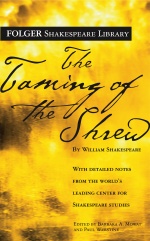The Taming of the Shrew: Difference between revisions
(→Film) |
|||
| Line 55: | Line 55: | ||
<html5media height "180" width "320">https://www.youtube.com/watch?v=ZiTQMypUgs8</html5media> | <html5media height "180" width "320">https://www.youtube.com/watch?v=ZiTQMypUgs8</html5media> | ||
In 1967, Richard Burton and Elizabeth Taylor put their real-life marriage to the test, starring as Petruchio and Katarina in | In 1967, Richard Burton and Elizabeth Taylor put their real-life marriage to the test, starring as Petruchio and Katarina in Franco Zeffirelli's technicolor telling of Shakespeare's classic play. | ||
<html5media height "180" width "320">https://www.youtube.com/watch?v=wUcKUpRxTgg</html5media> | <html5media height "180" width "320">https://www.youtube.com/watch?v=wUcKUpRxTgg</html5media> | ||
Revision as of 15:30, 29 January 2015
This article is about Shakespeare's play. For other uses, see The Taming of the Shrew (disambiguation).
Love and marriage are the concerns of The Taming of the Shrew, one of William Shakespeare's plays. Lucentio’s marriage to Bianca is prompted by his idealized love of an apparently ideal woman. Petruchio's wooing of Katherine, however, is free of idealism. Petruchio takes money from Bianca’s suitors to woo her, since Katherine must marry before her sister by her father's decree; he also arranges the dowry with her father. Petruchio is then ready to marry Katherine, even against her will.
Katherine, the shrew of the play’s title, certainly acts much changed. But have she and Petruchio learned to love each other?—or is the marriage based on terror and deception? This is just one of the questions this play raises for us.
The dating of The Taming of the Shrew is complicated. A play of the same name, printed and performed in 1594, may have been an early or reported version. Shakespeare's play was printed in the 1623 First Folio. Its sources include other contemporary works.[1]
Productions at the Folger
- Helen Hayes Awards
- Wins: "Outstanding Resident Play"
- Nominations: "Outstanding Ensemble, Resident Play," "Outstanding Director, Resident Play" for Aaron Posner, "The Robert Prosky Award for Outstanding Lead Actor, Resident Play" for Cody Nickell, "Outstanding Lead Actress, Resident Play" for Kate Eastwood Norris, "The James MacArthur Award for Outstanding Supporting Actor, Resident Play" for Danny Scheie, "Outstanding Supporting Actress, Resident Play" for Sarah Marshall, "Outstanding Supporting Actress, Resident Play" for Holly Twyford, and "Outstanding Sound Design, Resident Production" for Cliff Eberhardt, Original Music, and Christopher Baine, Sound Design
Early editions
First Folio
- LUNA: First Folio: S2v - 2v1r
- Hamnet: STC 22273 Fo. 1 no. 68
Second Folio
- LUNA: Second Folio: S2v - V1r
- Hamnet: STC 22274 Fo. 2 no. 07
First Quarto
- LUNA: First Quarto
- Hamnet: STC 22327 Copy 1
Modern editions
The Taming of the Shrew can be read online with Folger Digital Texts and purchased from Simon and Schuster. The play can also be purchased in Three Comedies, a collection that also includes A Midsummer Night's Dream and Twelfth Night.
Hamnet link to Folger Edition: PR2753 .M6 2002 copy 2 v.30
In popular culture
Film
Kiss Me Kate, Samuel and Bella Spewack's play adaptation with music by Cole Porter, appeared in cinemas in 1953. Presented as a play within a play where the lead couple's marital problems echo those of Shakespeare's Katarina and Petruchio. Enjoy the trailer featuring fantastic singing by Howard Keel and Kathryn Grayson (reprising their roles as lovers from the musical Showboat) and the dancing talents of Ann Miller.
In 1967, Richard Burton and Elizabeth Taylor put their real-life marriage to the test, starring as Petruchio and Katarina in Franco Zeffirelli's technicolor telling of Shakespeare's classic play.
Watch the trailer for the teen comedy remake of The Taming of the Shrew: 10 Things I Hate About You (1999) starring Julia Stiles and Heath Ledger.
Translations
Performance materials
Other media
Notes
<references>
- ↑ Adapted from the Folger Library Shakespeare edition, edited by Barbara A. Mowat and Paul Werstine. © 1992 Folger Shakespeare Library.


